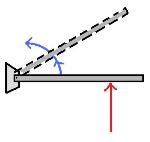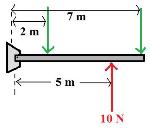LESSON 4: Moments

As you can see, the upward force (red arrow) causes the bar to spin around the pin joint. This is called a moment about a point. Remember the word “static” means still, and a key part of keeping something still is to keep it from rotating. This brings us to another main rule of statics: The sum of the moments about a point must equal zero. This simply means that all the forces on an object must be positioned in such a way that the object will not spin.

Every moment has a value, for example, some moments are stronger than others; an object can spin quickly with a lot of force or slowly with a small amount of force. The way to find this value is: (perpendicular distance) x (force of vector) = force of moment.


In this example our goal is to find the magnitudes of the two green vectors in order to keep this bar static. We will begin by summing the forces in the y-direction. Remembering from previous sections that the forces going up must equal the forces going down, we know that the two green vectors must add together to equal the red arrow ( 10 N) .

Tutorial Options:
Return to Home Page
Statics Lessons Home Page
Statics Example Problems
Continue to Next Section
Return to Home Page
Statics Lessons Home Page
Statics Example Problems
Continue to Next Section
Lesson 1:
Vectors
Magnitude
Unit Vectors
Cos Angles
Lesson 2:
Sum of Forces
Sum of Forces 2
Lesson 3:
3D Sum of Forces
Lesson 4:
Moments
Moments 2
Lesson 5:
Trusses
Method of Joints
Method of Sections
Lesson 6:
Distributed Load
Vectors
Magnitude
Unit Vectors
Cos Angles
Lesson 2:
Sum of Forces
Sum of Forces 2
Lesson 3:
3D Sum of Forces
Lesson 4:
Moments
Moments 2
Lesson 5:
Trusses
Method of Joints
Method of Sections
Lesson 6:
Distributed Load